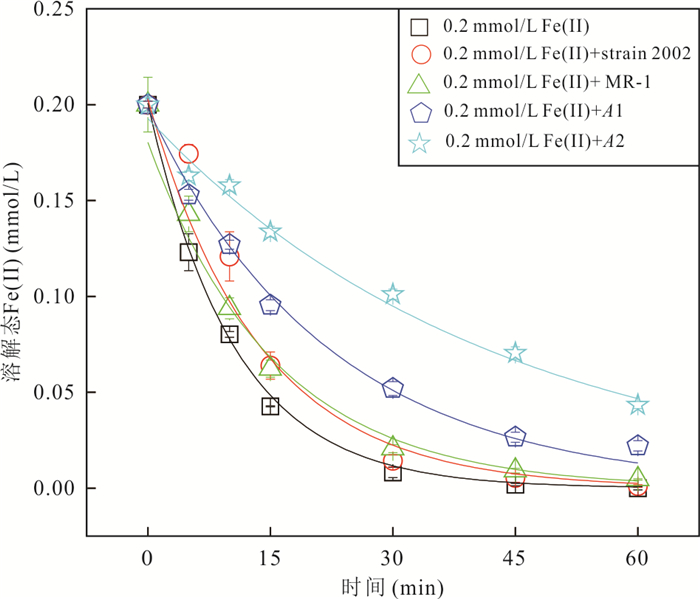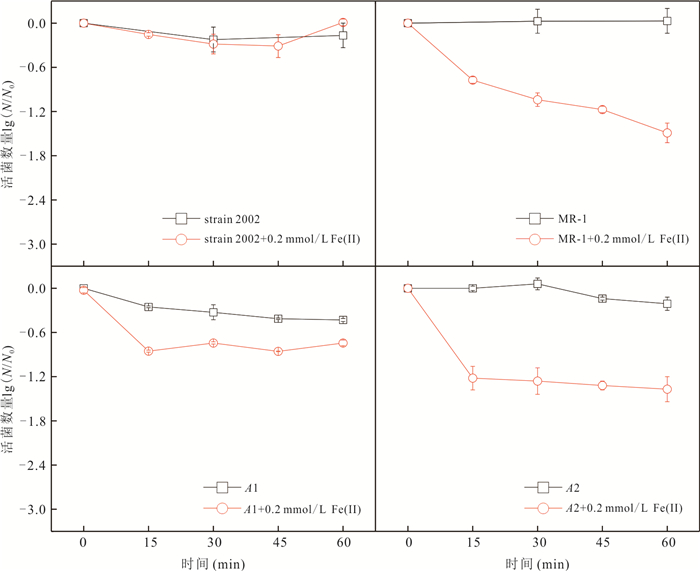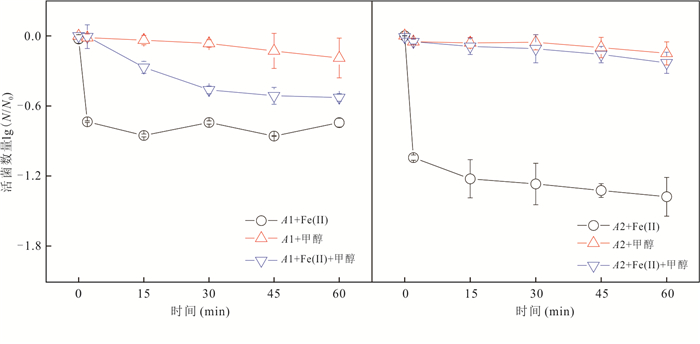|
Chen, R., Liu, H., Tong, M., et al., 2018. Impact of Fe(Ⅱ) Oxidation in the Presence of Iron-Reducing Bacteria on Subsequent Fe(Ⅲ) Bio-Reduction. The Science of the Total Environment, 639: 1007-1014. https://doi.org/10.1016/j.scitotenv.2018.05.241 |
|
Chen, R., Liu, H., Zhang, P., et al., 2019. Attenuation of Fe (Ⅲ)-Reducing Bacteria during Table Fluctuation of Groundwater Containing Fe2+. Science of the Total Environment, 694: 133660. https://doi.org/10.1016/j.scitotenv.2019.133660 |
|
Cornelis, P., Wei, Q., Andrews, S. C., et al., 2011. Iron Homeostasis and Management of Oxidative Stress Response in Bacteria. Metallomics, 3(6): 540-549. https://doi.org/10.1039/c1mt00022e |
|
Emerson, D., De Vet, W., 2015. The Role of FeOB in Engineered Water Ecosystems: A Review. Journal American Water Works Association, 107(1): E47-E57. https://doi.org/10.5942/jawwa.2015.107.0004 |
|
Grannas, A. M., Martin, C. B., Chin, Y. P., et al., 2006. Hydroxyl Radical Production from Irradiated Arctic Dissolved Organic Matter. Biogeochemistry, 78(1): 51-66. https://doi.org/10.1007/s10533-005-2342-4 |
|
He, J.Z., Zhang, L.M., 2009. Advances in Ammonia-Oxidizing Microorganisms and Global Nitrogen Cycle. Acta Ecologica Sinica, 29(1): 406-415(in Chinese with English abstract). http://www.oalib.com/paper/1401250 |
|
Heffron, J., McDermid, B., Mayer, B. K., 2019. Bacteriophage Inactivation as a Function of Ferrous Iron Oxidation. Environmental Science: Water Research & Technology, 5(7): 1309-1317. https://doi.org/10.1039/C9EW00190E |
|
Hu, M., Li, F.B., 2014. Soil Microbe Mediated Iron Cycling and Its Environmental Implication. Acta Pedologica Sinica, 51(4): 683-698(in Chinese with English abstract). http://d.wanfangdata.com.cn/periodical/trxb201404002 |
|
Imlay, J.A., 2003. Pathways of Oxidative Damage. Annual Review of Microbiology, 57(1): 395-418. https://doi.org/10.1146/annurev.micro.57.030502.090938 |
|
Joo, S. H., Feitz, A. J., Sedlak, D. L., et al., 2005. Quantification of the Oxidizing Capacity of Nanoparticulate Zero-Valent Iron. Environmental Science & Technology, 39(5): 1263-1268. https://doi.org/10.1021/es048983d |
|
Keenan, C. R., Sedlak, D. L., 2008. Factors Affecting the Yield of Oxidants from the Reaction of Nanoparticulate Zero-Valent Iron and Oxygen. Environmental Science & Technology, 42(4): 1262-1267. https://doi.org/10.1021/es7025664 |
|
Kim, J. Y., Park, H. J., Lee, C., et al., 2010. Inactivation of Escherichia coli by Nanoparticulate Zerovalent Iron and Ferrous Ion. Applied and Environmental Microbiology, 76(22): 7668-7670. https://doi.org/10.1128/aem.01009-10 |
|
Lee, C., Kim, J. Y., Lee, W. I., et al., 2008. Bactericidal Effect of Zero-Valent Iron Nanoparticles on Escherichia coli. Environmental Science & Technology, 42(13): 4927-4933. https://doi.org/10.1021/es800408u |
|
Liu, G.F., Zhu, J.Q., Yu, H.L., et al., 2018. Review on Electron-Shuttle-Mediated Microbial Reduction of Iron Oxides Minerals. Earth Science, 43(Suppl. 1): 157-170(in Chinese with English abstract). http://en.cnki.com.cn/Article_en/CJFDTotal-DQKX2018S1016.htm |
|
Lyons, T.W., Reinhard, C.T., Planavsky, N.J., 2014. The Rise of Oxygen in Earth's Early Ocean and Atmosphere. Nature, 506(7488): 307-315. https://doi.org/10.1038/nature13068 |
|
Ma, S.C., Tong, M., Yuan, S. H., et al., 2019. Responses of the Microbial Community Structure in Fe(Ⅱ)-Bearing Sediments to Oxygenation: The Role of Reactive Oxygen Species. ACS Earth and Space Chemistry, 3(5): 738-747. https://doi.org/10.1021/acsearthspacechem.8b00189 |
|
Melton, E.D., Swanner, E.D., Behrens, S., et al., 2014. The Interplay of Microbially Mediated and Abiotic Reactions in the Biogeochemical Fe Cycle. Nature Reviews Microbiology, 12(12): 797-808. https://doi.org/10.1038/nrmicro3347 |
|
Wang, R., Zheng, P., Zhang, M., et al., 2015. Nitrate-Dependent Anaerobic Ferrous/Iron Oxidation Microorganism: Review on Its Species, Distribution and Characteristics. Microbiology, 42(12): 2448-2456(in Chinese with English abstract). http://en.cnki.com.cn/Article_en/CJFDTOTAL-WSWT201512018.htm |
|
Weber, K.A., Achenbach, L.A., Coates, J.D., 2006. Microorganisms Pumping Iron: Anaerobic Microbial Iron Oxidation and Reduction. Nature Reviews Microbiology, 4(10): 752-764. https://doi.org/10.1038/nrmicro1490 |
|
Xie, S.C., Yang, H., Luo, G.M., et al., 2012. Geomicrobial Functional Groups: A Window on the Interaction between Life and Environments. Chinese Science Bulletin, 57(1): 3-22(in Chinese). doi: 10.1360/csb2012-57-1-3 |
|
Zhang, P., Yuan, S.H., 2017. Production of Hydroxyl Radicals from Abiotic Oxidation of Pyrite by Oxygen under Circumneutral Conditions in the Presence of Low-Molecular-Weight Organic Acids. Geochimica et Cosmochimica Acta, 218: 153-166. https://doi.org/10.1016/j.gca.2017.08.032 |
|
Zhang, X., Chen, T.H., Wang, J., et al., 2018. Influence of Iron Oxides on Methanogenic Process of Organic Matter and Related Mechanism. Earth Science, 43(Suppl. 1): 136-144(in Chinese with English abstract). http://www.zhangqiaokeyan.com/academic-journal-cn_earth-science_thesis/0201272213930.html |
|
Zhao, L., 2013. Influence of Elodea Nuttallii-Nitrogen Cycling Bacteria on Nitrogen Cycling of Shallow Eutrophic Taihu Lake, China(Dissertation). Nanjing University, Nanjing(in Chinese with English abstract). |
|
Zhao, L.D., Dong, H.L., Kukkadapu, R., et al., 2013. Biological Oxidation of Fe(Ⅱ) in Reduced Nontronite Coupled with Nitrate Reduction by Pseudogulbenkiania sp. Strain 2002. Geochimica et Cosmochimica Acta, 119: 231-247. https://doi.org/10.1016/j.gca.2013.05.033 |
|
贺纪正, 张丽梅, 2009. 氨氧化微生物生态学与氮循环研究进展. 生态学报, 29(1): 406-415. doi: 10.3321/j.issn:1000-0933.2009.01.049 |
|
胡敏, 李芳柏, 2014. 土壤微生物铁循环及其环境意义. 土壤学报, 51(4): 683-698. https://www.cnki.com.cn/Article/CJFDTOTAL-TRXB201404002.htm |
|
柳广飞, 朱佳琪, 于华莉, 等, 2018. 电子穿梭体介导微生物还原铁氧化物的研究进展. 地球科学, 43(增刊1): 157-170. doi: 10.3799/dqkx.2018.590 |
|
王茹, 郑平, 张萌, 等, 2015. 硝酸盐型厌氧铁氧化菌的种类、分布和特性. 微生物学通报, 42(12): 2448-2456. https://www.cnki.com.cn/Article/CJFDTOTAL-WSWT201512018.htm |
|
谢树成, 杨欢, 罗根明, 等, 2012. 地质微生物功能群: 生命与环境相互作用的重要突破口. 科学通报, 57(1): 3-22. https://www.cnki.com.cn/Article/CJFDTOTAL-KXTB201201005.htm |
|
张勋, 陈天虎, 王进, 等, 2018. 铁氧化物对有机质厌氧产甲烷过程的影响及其机制. 地球科学, 43(增刊1): 136-144. doi: 10.3799/dqkx.2018.545 |
|
赵琳, 2013. 伊乐藻-氮循环菌共同作用对太湖氮循环的影响(硕士学位论文). 南京: 南京大学. |










 下载:
下载:





